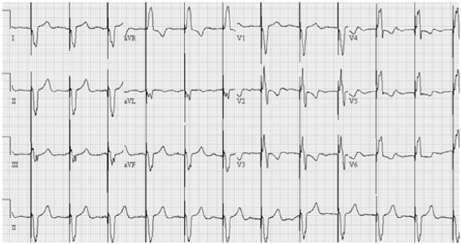Korean Circ J.
2008 Feb;38(2):128-130. 10.4070/kcj.2008.38.2.128.
Successful Pacemaker Revision Through Sustained Right Superior Vena Cava in a Patient With Situs Inversus Totalis
- Affiliations
-
- 1Department of Internal Medicine, Seoul National University College of Medicine, Seoul, Korea. seil@snu.ac.kr
- KMID: 2225855
- DOI: http://doi.org/10.4070/kcj.2008.38.2.128
Abstract
- In patients with situs inversus totalis, the superior vena cava is normally positioned on the left side and drains into a left-sided right atrium (RA). If right-side superior vena cava (RSVC) is also present, it should be thought of as a combined congenital anomaly. Here, we report a case of successful pacemaker lead insertion through the RSVC in a patient with situs inversus totalis. The left-side superior vena cava (LSVC) had been already used as a route for the first pacemaker lead insertion 15 years earlier. During the pacemaker lead revision, we found that the LSVC was obliterated, and used the RSVC as a route for a new pacemaker lead insertion.
Figure
Reference
-
1. Biffi M, Boriani G, Frabetti L, Bronzetti G, Branzi A. Left superior vena cava persistence in patients undergoing pacemaker or cardioverter-defibrillator implantation: a 10-year experience. Chest. 2001. 120:139–144.2. Murayama H, Maeda M, Sakurai H, Watanabe T. Absent left superior vena cava with persistent right superior vena cava in visceroatrial situs inversus. Pediatr Cardiol. 2006. 27:293–296.3. Son JW, Lee CS, Han SW, Lee SW, Kim SK, Kwon YJ. A case of persistent left SVC associated with tricuspid regurgitation. Korean Circ J. 1993. 23:609–613.4. Campbell M, Deuchar DC. The left-sided superior vena cava. Br Heart J. 1954. 16:423–439.5. Morgan DR, Hanratty CG, Dixon LJ, Trimble M, O'Keeffe DB. Anomalies of cardiac venous drainage associated with abnormalities of cardiac conduction system. Europace. 2002. 4:281–287.6. Nsah EN, Moore GW, Hutchins GM. Pathogenesis of persistent left superior vena cava with a coronay sinus connection. Pediatr Pathol. 1991. 11:261–269.7. Rigatelli G. Congenitally persistent left superior vena cava: a possible unpleasant problem during invasive procedures. J Cardiovasc Med (Hagerstown). 2007. 8:483–487.8. Raghib G, Ruttenberg HD, Anderson RC, Amplatz K, Adams P Jr, Edwards JE. Termination of left superior vena cava in left atrium, atrial septal defect, and absence of coronary sinus: a developmental complex. Circulation. 1965. 31:906–918.9. Jeong SY, Sin PJ, Cho SY, et al. A case of situs inversus (I.D.D.) with corrected TGA. Korean Circ J. 1993. 23:296–301.10. Gonzalez-Juanatey C, Testa A, Vidan J, et al. Persistent left superior vena cava draining into thecoronary sinus: report of 10 cases and literature review. Clin Cardiol. 2004. 27:515–518.11. Zaglavara T, Hamilton JR, Kenny A. A combination of persistent left superiorvena cava and a large secundumatrial septal defect in a 34 year old woman. Heart. 2001. 85:406.12. Gheissari A, Malm JR, Bowman FO Jr, Bierman FZ. Cor triatriatumsinistrum: one institution's 28-year experience. Pediatr Cardiol. 1992. 13:85–88.13. Krukal JC. Transvenous pacemaker failure due to anomalous venous return to the heart. Chest. 1971. 59:458–461.14. Garcia L, Levine R, Kosowsky W, Lyon AF. Persistent left superior vena cava complicating pacemaker insertion. Chest. 1972. 61:396–397.15. Rubenfire M, Evangelista J, Wajszczuk WJ, Kantrowitz A. Implication of a persistent left superior vena cava in transvenous pacemaker therapy and cardiac hemodynamic monitoring. Chest. 1974. 65:145–147.
- Full Text Links
- Actions
-
Cited
- CITED
-
- Close
- Share
- Similar articles
-
- Single Port Laparoscopic Cholecystectomy in a Patient with Situs Inversus Totalis: A Case Report
- Neonatal Duodenal Obstruction Associated with Situs Inversus Totalis: A Case Report
- Laparoscopic Low Anterior Resection in a Rectal Cancer Patient with Situs Inversus Totalis: A Case Report
- Laparoscopic cholecystectomy in a case of situs inversus totalis: a review of technical challenges and adaptations
- Radical Subtotal Gastrectomy in Early Gastric Cancer Patient with Situs Inversus Totalis






